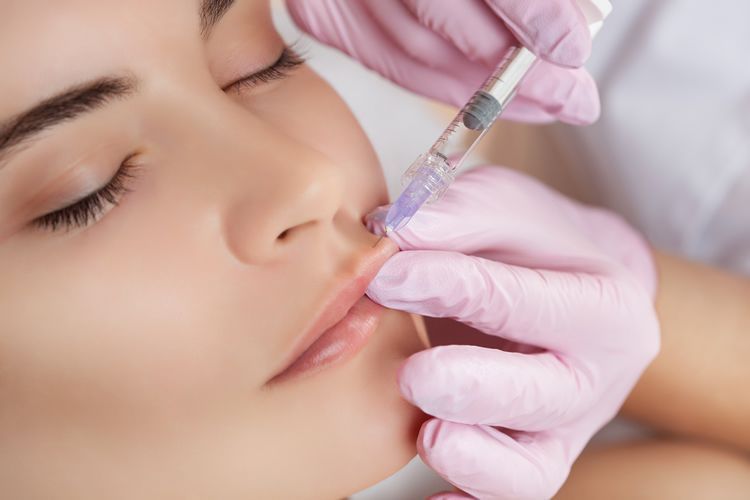
Facial fillers are a frequently preferred anti-aging application to add volume to the tissues that have lost their volume by age, to correct asymmetries, and to provide lifting on the face.
While the filler classification was previously done as temporary and permanent (silicone, etc.) fillers, now it is divided into hyaluronic acid fillers and other fillers. The aim here is that hyaluronic acid fillers can produce molecules with very similar properties to intercellular connective tissue thanks to the developing nano technologies, and these are fillings that are very similar to our tissues, which can be called as organic. Other fillers, although hyaluronic acid, are compatible with the tissue, which we call biocompatible, and contribute to long-term skin rejuvenation as well as the volume effect it gives by providing tissue regeneration by stimulating on-site collagen synthesis while melting. Such fillers are biostimulant.
In our body, hyaluronic acid is found in an area called as the intercellular matrix. This area not only serves to hold the cells together like cement, but also stores the water and nutrients needed by the cells. It can hold water about 100-1000 times its volume. In this way, it provides moisture to the skin.
With increasing age, the power of fibroblasts, which are the cells that produce collagen, elastin and hyaluronic acid, decreases. It is insufficient to complete for the missing amounts. This situation manifests itself as melted facial areas, decreased moisture of the skin, pale skin, wrinkles and sagging. Thanks to the fillers, this deficiency can be replaced.
Hyaluronic acid fillers are the most commonly used type of fillers.
Most frequently preferred fields:
Forehead: There may be differences between men and women in the forehead region. Especially in women, a curved forehead also contributes to the formation of a feminine perception. Controlled and carefully applied fillers between the eyebrows help to correct the groove that develops due to the itching movement between the eyebrows, together with botox.
Temporal region: Temporal areas are the locations where the fat pads have melted at the earliest. In these people, a bony face appearance causes a po-faced appearance. Filling is sometimes applied to these areas to soften the expression and to lift the eyebrows that have fallen over time.
Under-eye: Under-eye light fillers is also done to replace the fat pads that melt under the eyes over time. In this way, the collapsed and tired old appearance leaves its place to a vivid appearance. When the light reflected from the flattened skin surface will be much more than the hollow areas, a beautiful and vivid under-eye appearance is provided.
Nose: Nasal filler is preferred for the patients who do not need surgery, but have a curvature on the back of the nose and drooping at the tip of the nose. However, it is never a solution to problems such as deviation that can replace surgical operations.
Lips: It is used to plump the lips, correct asymmetries, moisturize, provide the golden ratio, adapt the lips to the face shape, and also used for lip cracks.
Cheeks: Cheek fillers are applied to replace the sagging and decreasing cheek volume over time, and sometimes to protect the popular perception of beauty and the golden ratio.
Nasolabial cavities: The cavities extending from the side of the wings to the side of the mouth become evident both with the sagging of the cheeks with age and with the melting of the fat pads in this area. Since the fillers applied in this area alone will not solve the problem, it is usually supported with cheek filling to pull the sagging areas up (liquid face lift, lifting).
Chin: Fillers are applied as a part of the holistic facial approach in those whose chin is small compared to their nose, lips and cheeks, behind and asymmetrical. In this way, it is possible to obtain sharp jaw lines and pointing towards the front, which prevents sharper sagging.
Neck lines: Wrinkles in the neck area are treated with semi-cross-linked thin fillers.
Filler applications are comfortable applications that can be applied in a short period of time. Permanence term is about 6 months to 2 years. The reason for this wide time interval is primarily the molecular weight of the filler, the cross-link ratio, the applied area (melting is fast in movable areas such as lips) and subcutaneous rejuvenating applications such as golden needle, PRP, laser applied after surgery, heat, young individuals and individuals with rapid skin regeneration process cause difference in the filler use periods.
Thanks to the local anesthetic creams applied before the procedure, the pain is minimized. Process time is between 10 and 30 minutes depending on the location and the amount used.
Bruising after the procedure is among the most common side effects.
Rarely, infection and vascular occlusion may occur. In such a case, informing your doctor as soon as possible will solve the problem in a short time with early treatment. Vascular occlusion is a very rare condition if done in accordance with the anatomy. Application of fillers by those who do not have anatomy knowledge is quite risky. In competent hands, this risk is minimized. In such a case, enzymes called hyaluronidase that quickly dissolve the filler are used.
